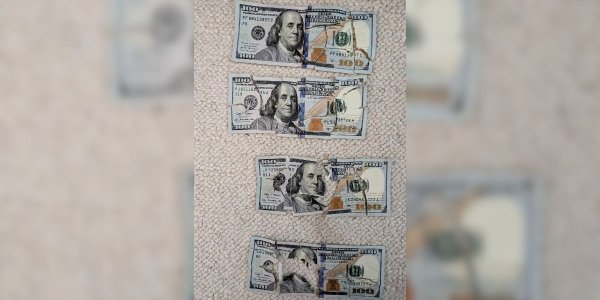Say farewell to these familiar faces: These bills will no longer be accepted in stores!
- Replies 0
In an era where the tap of a card or the click of a button can complete a transaction, the physical currency in our wallets is undergoing a transformation of its own. The value of a dollar—both in purchasing power has stories that each bill could tell.
But as we move forward, it's crucial to stay informed about the changes affecting our cash, especially when it comes to which bills will remain welcome in our daily exchanges. What happens when these bills’ stories end?
The Bureau of Engraving and Printing (BEP), alongside the Secret Service and the Advanced Counterfeit Deterrence (ACD) Steering Committee, has ushered in a new policy that's set to redefine the landscape of legal tender.
This new policy, which took effect last October, allows stores, businesses, banks, and ATMs across the United States to say a firm “no thank you” to any bill that falls under the category of “mutilated.” Lower denomination bills are highlighted in this change since these are more commonly used and damaged easier.
This change is not just about aesthetics; it's a strategic move to safeguard the integrity of the U.S. dollar and to ensure the currency that passes through our hands is as secure as possible, especially in the wake of counterfeit bills.

The bills that are considered legal tender in the United States include the familiar $1, $2, $5, $10, $20, $50, and $100 notes.
But did you know that there are also older, larger denominations still out there? The $500, $1,000, and even the $10,000 notes are no longer printed but are legally exchangeable until they're worn out and retired.
These rarities, especially the $10,000 bill, which hasn't been issued since 1969, are more often the treasures of private collectors than the spare change in our grocery funds. They can also be sold to another collector–which can get you a higher value for it.
But what exactly does “mutilated” mean in this context?
The BEP defines mutilated currency as bills that have been so damaged that either half or less of the original note remains, or its condition is so compromised that its value is questionable.
This can happen through a variety of unfortunate events—fires, floods, chemical spills, or even the gnawing curiosity of pets and pests.
It's important to note that not all damaged currency is considered mutilated. Bills that are merely dirty, defaced, limp, torn, or worn may still be exchanged at financial institutions. They're unfit for circulation, but not beyond redemption.
If you find yourself with a mutilated bill, don't despair. While you can't use it at your local store or deposit it at the bank, you can send it directly to the BEP. There, experts will use specialized tools to verify its authenticity and determine its value. If your claim is accepted, the BEP will issue a reimbursement.
“The BEP will evaluate the note. They have special tools to examine the authenticity and assess the full value of the note. After they do that, they can issue a check back to the consumer,” a Fed currency representative stated.
This initiative is part of a broader effort to maintain the American dollar's value and to pave the way for new, redesigned bills that will be much harder to counterfeit.
These updated notes for the $5, $20, $50, and $100 bills will feature advanced security measures and are set to be released in a staggered schedule from 2028 to 2038.
In the meantime, how can you ensure the bills in your wallet are the real deal? Here are a few quick tips to spot a genuine bill:
- Look for a light-resistant security thread with the inscription 'USA' embedded in the fabric of the note.
- Check for a 3D security ribbon that shifts when you tilt the bill.
- Observe the ink in the lower right corner of the bill; it should change color with different angles.
- Hold the bill up to the light to see if a watermark is present.
While on the subject of saying farewell to our beloved bills, you might want to learn more about the upcoming money makeover through this story here.

Have you encountered a mutilated bill recently? Do you have any tips for distinguishing real currency from counterfeit? Or perhaps you have a story about the largest bill you've ever handled? Share your insights and anecdotes in the comments below!
But as we move forward, it's crucial to stay informed about the changes affecting our cash, especially when it comes to which bills will remain welcome in our daily exchanges. What happens when these bills’ stories end?
The Bureau of Engraving and Printing (BEP), alongside the Secret Service and the Advanced Counterfeit Deterrence (ACD) Steering Committee, has ushered in a new policy that's set to redefine the landscape of legal tender.
This new policy, which took effect last October, allows stores, businesses, banks, and ATMs across the United States to say a firm “no thank you” to any bill that falls under the category of “mutilated.” Lower denomination bills are highlighted in this change since these are more commonly used and damaged easier.
This change is not just about aesthetics; it's a strategic move to safeguard the integrity of the U.S. dollar and to ensure the currency that passes through our hands is as secure as possible, especially in the wake of counterfeit bills.

Bills considered “mutilated” include those with severe damage or questionable value, and they cannot be exchanged at financial institutions. Image source: GrandAdhesiveness145 via Reddit.
The bills that are considered legal tender in the United States include the familiar $1, $2, $5, $10, $20, $50, and $100 notes.
But did you know that there are also older, larger denominations still out there? The $500, $1,000, and even the $10,000 notes are no longer printed but are legally exchangeable until they're worn out and retired.
These rarities, especially the $10,000 bill, which hasn't been issued since 1969, are more often the treasures of private collectors than the spare change in our grocery funds. They can also be sold to another collector–which can get you a higher value for it.
But what exactly does “mutilated” mean in this context?
The BEP defines mutilated currency as bills that have been so damaged that either half or less of the original note remains, or its condition is so compromised that its value is questionable.
This can happen through a variety of unfortunate events—fires, floods, chemical spills, or even the gnawing curiosity of pets and pests.
It's important to note that not all damaged currency is considered mutilated. Bills that are merely dirty, defaced, limp, torn, or worn may still be exchanged at financial institutions. They're unfit for circulation, but not beyond redemption.
If you find yourself with a mutilated bill, don't despair. While you can't use it at your local store or deposit it at the bank, you can send it directly to the BEP. There, experts will use specialized tools to verify its authenticity and determine its value. If your claim is accepted, the BEP will issue a reimbursement.
“The BEP will evaluate the note. They have special tools to examine the authenticity and assess the full value of the note. After they do that, they can issue a check back to the consumer,” a Fed currency representative stated.
This initiative is part of a broader effort to maintain the American dollar's value and to pave the way for new, redesigned bills that will be much harder to counterfeit.
These updated notes for the $5, $20, $50, and $100 bills will feature advanced security measures and are set to be released in a staggered schedule from 2028 to 2038.
In the meantime, how can you ensure the bills in your wallet are the real deal? Here are a few quick tips to spot a genuine bill:
- Look for a light-resistant security thread with the inscription 'USA' embedded in the fabric of the note.
- Check for a 3D security ribbon that shifts when you tilt the bill.
- Observe the ink in the lower right corner of the bill; it should change color with different angles.
- Hold the bill up to the light to see if a watermark is present.
While on the subject of saying farewell to our beloved bills, you might want to learn more about the upcoming money makeover through this story here.
Key Takeaways
- The US has introduced a policy to reject any “mutilated” bills at stores, businesses, banks, and ATMs to combat counterfeiting.
- Bills considered “mutilated” include those with severe damage or questionable value, and they cannot be exchanged at financial institutions.
- Individuals with “mutilated” currency must file a claim directly with the Bureau of Engraving and Printing (BEP) for evaluation and possible reimbursement.
- The Federal Reserve is preparing to release redesigned $5, $20, $50, and $100 bills with enhanced security features to prevent counterfeiting, with the new $50 bill expected in 2028 and the others to follow.
Have you encountered a mutilated bill recently? Do you have any tips for distinguishing real currency from counterfeit? Or perhaps you have a story about the largest bill you've ever handled? Share your insights and anecdotes in the comments below!
Last edited:






